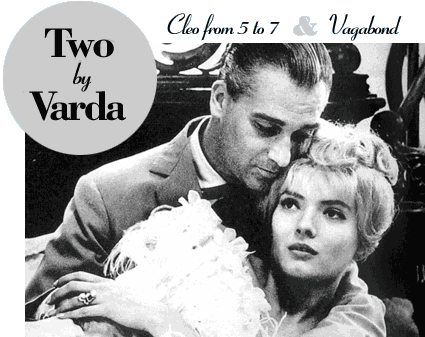 | DVD cover artwork for Vagabond.
[click photo for larger version] |
Vagabond's central character is Mona Bergeron
(Sandrine Bonnaire), a young woman who gives up her
secretary job to live, as the French title indicates,
"without roof or rule." Mona wanders though la France
profonde and has many encounters: she co-habitates with a
new boyfriend in an abandoned villa, she stays with a young
couple who herd sheep (until they justifiably accuse her
of being lazy and she leaves), she develops an uneasy
friendship with a college professor, she works pruning
vineyards with a new Tunisian boyfriend, and finally she
falls in with a gang hanging out at a bus terminal,
initiating a series of events that lead to her death.
Although Cléo focuses on a celebrity in existential
crisis and Vagabond tells the story of the life and death
of a homeless "nobody," various concerns and themes unite
the two films. Vagabond is punctuated with long, patient
shots of Mona trooping across the rural French countryside,
shots which, like the scenes through the windshield in
Cléo, give us an documentary sense of the protagonist's
surroundings. And both films are obsessed with the dynamics
of the gaze, male and otherwise. Men constantly look at
Cléo, and the café scene makes it clear that she has
internalized these gazes and now believes that physical
beauty and fame is all she has to offer to the world. One
of the earliest shots in Vagabond shows Mona, in a
non-invasive long shot, emerging naked from the sea and
striding on a beach; in subsequent shots, two young toughs
stare at her and talk about how she "wants it," but these
guys, perhaps sensing her strength and iconoclasm, are
afraid to approach her. Varda builds on Mona's strength
throughout the film, characterizing her as both an object
of male desire and as a sexual being with desires and
attractions that she expresses and initiates. Mona rejects
the advances of a horny truck driver ("No rides for free,
eh?"), initiates the romance with the Tunisian vine-pruner
by holding his hand, and reacts to a picture of a man by
saying, "He's cute...I could go for him," even while
carrying on a conversation with the man's girlfriend. By
dropping out of conventional society, she leaves behind
conventional sexual mores as well, challenging male gazes
even while she engages in looks and lusts of her own.
Cléo From 5 to 7 makes reference to other films and filmmakers
through various instances of clever casting; one of the
musicians that drives Cléo out of her apartment is nouvelle
vague composer Michel Legrand, and midway through the film
Cléo watches a brief film-within-a-film, a parody of a
silent comedy, that stars Jean-Luc Godard, Anna Karina, and
Eddie Constantine. Vagabond, however, alludes to other
movies in different and more profound ways. Vagabond begins
with Mona frozen to death in a ditch and is structured as
a series of flashback reminiscences offered up by the
people that Mona met during the last three months of her
life. As Varda acknowledges (and as several critics, most
notably Sandy Flitterman-Lewis, have discussed in detail),
this structure is cribbed from Citizen Kane, a move that
punctures Kane's bourgeois sense of tragedy and
self-importance by implicitly suggesting that to die alone,
old, rich, and in a comfortable bed is better than to die
alone, poor, and young due to starvation and exposure.
Another film Vagabond cites is Godard's classic
Weekend (1967). The films share many similarities,
including:
- Somewhat unlikeable protagonists (Mona, Weekend's
married couple Roland and Corinne) traveling through a
rural France defined by its sexual predation (particularly
in and around cars and trucks) and grueling labor;
- "Philosophical" characters (Vagabond's philosophy
scholar turned goat farmer, Tom Thumb and Emily Brönte in
Weekend) who condemn the behavior of the central
protagonists;
- Representatives workers from the "Third World" (Mona's
Tunisian boyfriend, the Arab and African garbagemen) that
allow both auteurs to comment on imperialism; and
- A scene in each film where a woman (Mona, Corinne) is
assaulted in the woods, and the camera tracks past the
human figures, denying the audience a view of the rape as
it occurs.
So why does Varda make these connections? One significant
difference is that Weekend is outrageously satiric; Godard
presents the film's cannibalism, auto-violence, and sexual
politics in exaggerated, surreal, hysterical, Buñuelian
ways, but Vagabond is a scrupulously realistic film. Mona
lives in a world where there are no free rides: everyone
exploits everyone else, and that's just the way things are.
And Vagabond's casual portrayal of these brute facts makes
the film, for me, much sadder than either Weekend or
Citizen Kane.
Cléo and Vagabond are quintessential examples of
the art film, a mode of narration which, according to David
Bordwell, includes ambiguous characters, meandering,
episodic plots, serious themes, and non-narrative flourishes
of style. I adore foreign art films, and I love all of
Varda's work that I've seen, but I also realize that the
art film is a relic of the past and that most contemporary
spectators consider movies such as Lock, Stock And Two Smoking
Barrels (1998) and Dogma (1999) ambiguous and "arty" enough
for their tastes. Folks like this should stay a hundred
miles away from Vagabond. But if you value the work
of such great foreign auteurs as Akira Kurosawa, Federico Fellini, and
Abbas (Taste of Cherry) Kiarostami (and I'd certainly include Varda on this list),
or if you love the films of the French New Wave, you'll
find these DVDs indispensable.

